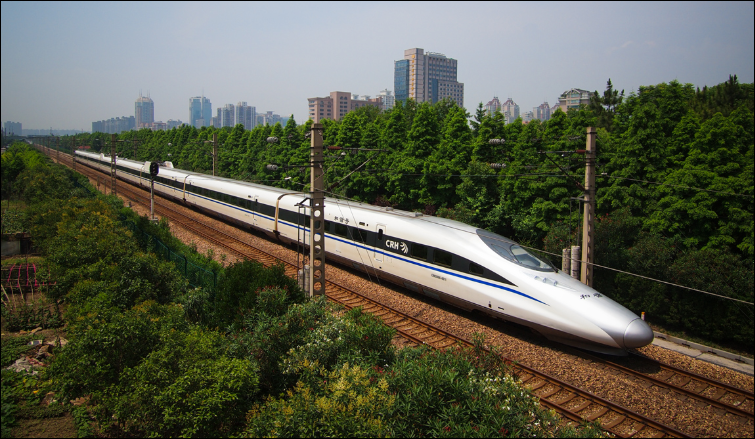If I were to tell you that the US’s standard railway gauge of 4 feet 8.5 inches have not changed since its 1st railway between Baltimore and Ohio in 1827, you would say that I was joking. No! I am not joking! If you don’t believe me, you can Google to find the truth. There is no High-Speed Railway in America.
The importance of Rail transport
Good physical connectivity in the urban and rural areas is essential for economic growth. Rail experts believe that the rail transport systems are six times more energy efficient than road and four times more economical. The social costs in terms of environment damage or degradation are significantly lower in rail.
USA do not have high speed rail. The average annual US’s GDP is about 2.5 % and China’s annual GDP is about 7.5%. This is one of the reasons how China’s GDP has been growing 3 times faster than USA in the last 30 years. China has lifted 500 million people out of poverty in the last 30 years.
I have been to China about 20 times. In fact, I still have a few relatives living in Xiamen.
A few years ago, I travelled from Beijing to Shanghai by the High-Speed Rail (HSR). The journey of 1,100 km took only 4 hour 18 minutes. The train travelled at 250-350 km/h.
I also took the Magley, the world's first high-speed commercial magnetic levitational track line, whose trains run on non-conventional track and reach a top speed of 430 km/h (267 mph) from Shanghai Airport to the city. The journey of 30 km took 10 minutes.
High-speed rail (HSR) in China consists of a network of passenger-dedicated railways designed for speeds of 250–350 km/h (155–217 mph). It is the world's longest high-speed rail network and is also the most extensively used. China's HSR accounts for two-thirds of the world's total high-speed railway networks. In 2019, China started testing a magnetic levitation ("maglev") prototype train that runs at 600 km/h.
By the end of 2019 December, HSR extended to 32 of the country's 34 provincial-level administrative divisions, the exceptions being Macau, and Tibet, with further Ningxia and Hainan currently only have isolated high-speed lines. The national network and reached 35,000 km (22,000 mi) in total length, accounting for about two-thirds of the world's high-speed rail tracks in commercial service. The HSR building boom continues with the HSR network set to reach 38,000 km (24,000 mi) in 2025.
Almost all HSR trains, track and service are owned and operated by the China Railway Corporation under the brand China Railway High-speed (CRH). The China Railway High-speed (CRH) high-speed train service was introduced in April 2007 featuring high-speed train sets called Hexie Hao (simplified Chinese: 和谐号traditional Chinese: 和諧號)

High-speed rail developed rapidly in China over the past 15 years with substantial funding from the Chinese government, especially the economic stimulus program during the Great Recession.
China's early high-speed trains were imported or built under technology transfer agreements with foreign train-makers including Alstom, Siemens, Bombardier and Kawasaki Heavy Industries. Since the initial technological support, Chinese engineers have re-designed internal train components and built indigenous trains manufactured by the state-owned CRRC Corporation.
The advent of high-speed rail in China has greatly reduced travel time and has transformed Chinese society and economy. A World Bank study found "a broad range of travellers of different income levels choose HSR for its comfort, convenience, safety and punctuality."
Notable HSR lines in China include the Beijing–Guangzhou high-speed railway which at 2,298 km (1,428 mi) is the world's longest HSR line in operation, the Beijing–Shanghai high-speed railway with the world's fastest operating conventional train services and the Shanghai Maglev, the world's first high-speed commercial magnetic levitation line, whose trains run on non-conventional track and reach a top speed of 430 km/h (267 mph).
First train from China to Europe Within the scope of the Belt and Road Initiative (BRI), which aims to connect Asia, Africa and Europe via roads and sea lanes, the railway will reduce freight transportation time between China and Turkey from one month to 12 days thanks to the Baku-Tbilisi-Kars (BTK) railway line, while the whole route between the Far East and Western Europe will take 18 days with the integration of the Marmaray tunnel, said Transportation and Infrastructure Minister Cahit Turhan at the welcoming and send off ceremony at the historic Ankara Train Station recently.
https://klse.i3investor.com/blogs/koonyewyinblog/2020-05-01-story-h1506850536-China_s_High_Speed_Rail_Koon_Yew_Yin.jsp
